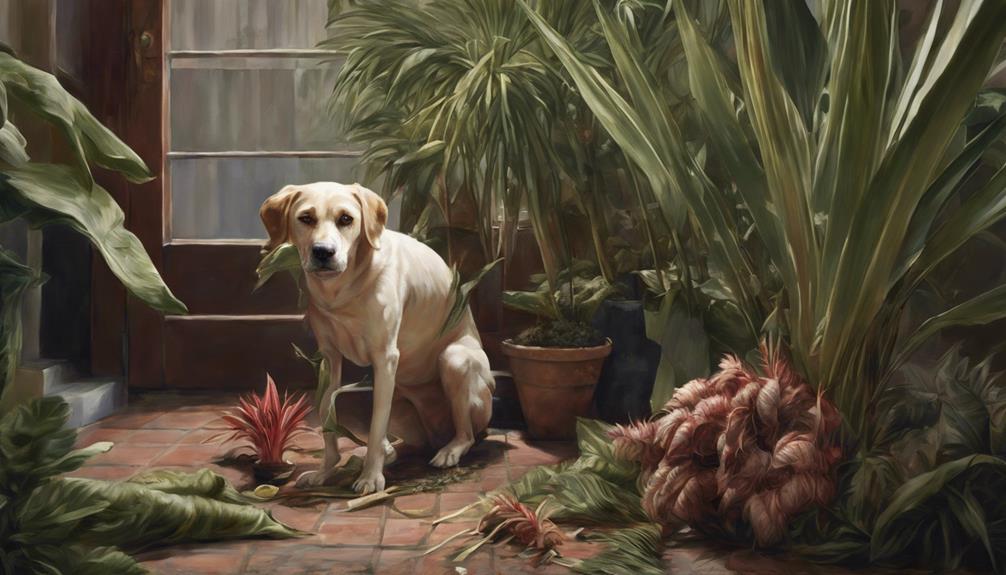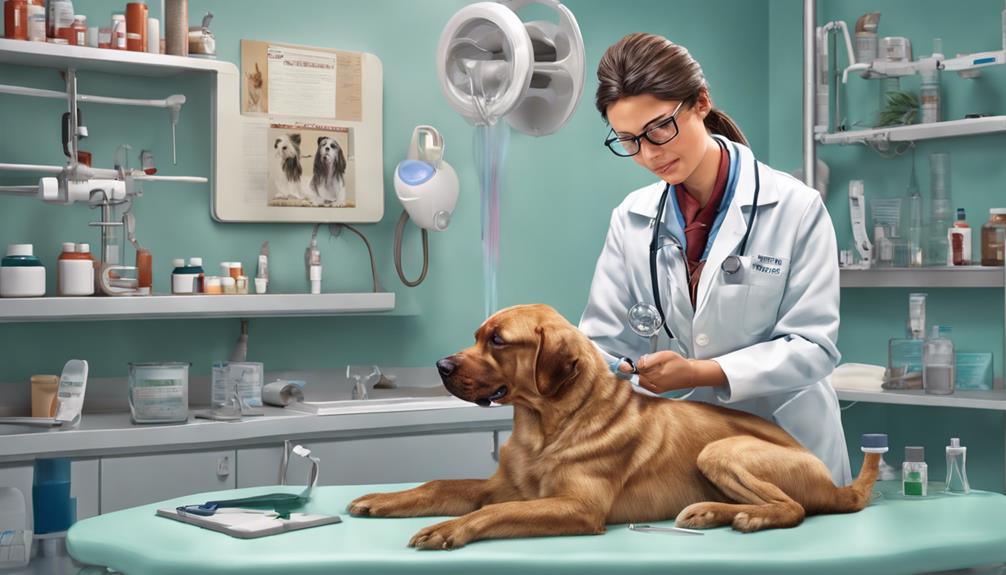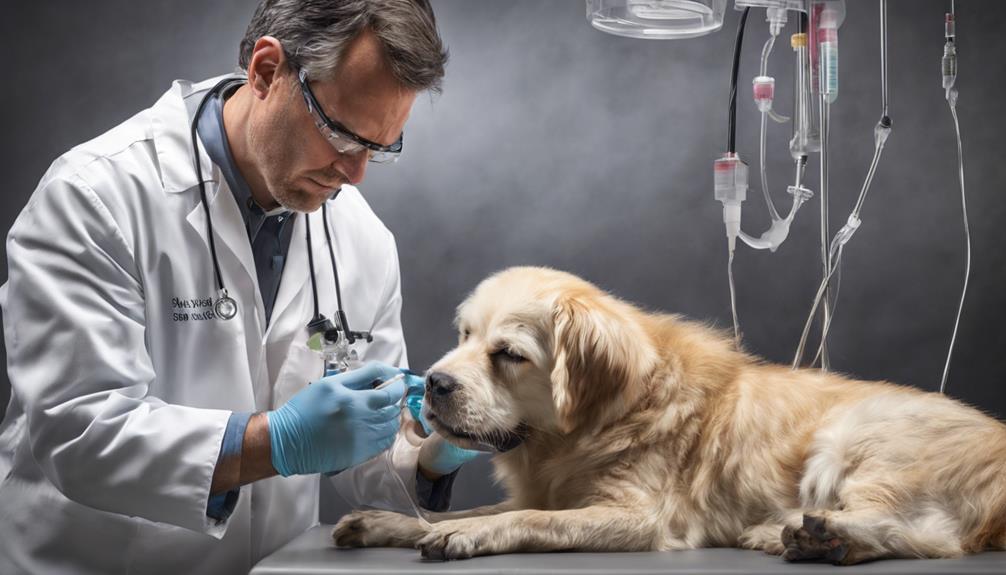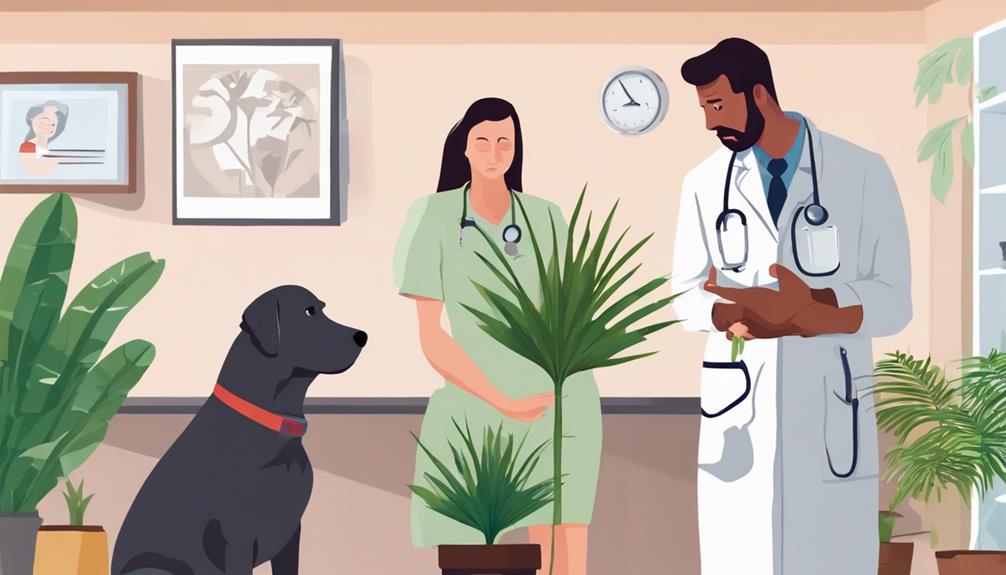Cordyline plants, like Ti or Hawaiian Ti, are dangerous for dogs due to toxic compounds such as saponins found in all parts. Symptoms of ingestion include vomiting, weakness, and dilated pupils. If toxicity is suspected, induce vomiting, administer activated charcoal, and seek prompt veterinary care. Diagnosing poisoning involves physical exams, tests, and x-rays. Treatments include medication, fluid therapy, and close monitoring. Berries, leaves, and roots carry varying poison levels. Keep pets away from these plants. Consult a vet immediately if ingestion occurs. Veterinary care is essential for managing cordyline toxicity in dogs effectively. Discover more about protecting your furry friends.
Key Takeaways
- Cordyline plant is toxic to dogs due to saponins in all parts.
- Symptoms include vomiting, weakness, and dilated pupils.
- Emergency actions include inducing vomiting and seeking vet care.
- Prompt veterinary diagnosis and treatment are crucial.
- Keep Cordyline plants out of reach to prevent toxicity.
Cordyline Plant Overview
Investigating the harmful nature of the Cordyline plant reveals its potential dangers to dogs. The Cordyline plant, also known as Ti plant or Hawaiian Ti, is a common decorative plant found in many households and gardens. This plant contains toxic compounds, such as saponins, in all its parts, including the berries and roots. These compounds can be harmful to our canine companions if ingested. Dogs may experience symptoms like loss of muscle control, weakness, and gastrointestinal issues if they consume any part of the Cordyline plant. It's vital for pet owners to be aware of the potential dangers this plant poses to their furry friends.
As responsible pet owners, it's important to make sure that our dogs don't have access to the Cordyline plant to prevent accidental ingestion. By being vigilant and keeping our pets away from this toxic plant, we can protect them from experiencing harmful effects on their health. Remember, prevention is essential when it comes to keeping our furry friends safe from toxic plants like the Cordyline.
Common Symptoms of Toxicity

What're the common symptoms of toxicity in dogs exposed to cordyline plants? Dogs can show various signs of toxicity if they ingest parts of the cordyline plant. Some common symptoms include vomiting, weakness, loss of muscle control, and dilated pupils.
These signs can occur immediately or may be delayed, depending on the amount ingested. The toxic compounds present in cordyline, such as saponins and glycosides, are responsible for these harmful effects on dogs. Saponins and glycosides can lead to serious health issues in our canine friends, so it's essential to be aware of these symptoms if your dog has been near or ingested a cordyline plant.
If you notice any of these signs or suspect cordyline toxicity, seek immediate veterinary attention. Remember, prompt diagnosis and proper treatment are crucial for the recovery of dogs exposed to cordyline toxicity. Keep a close eye on your furry companion and act promptly if you suspect any issues related to plants toxic to dogs.
Emergency Actions to Take

After observing symptoms of cordyline toxicity in dogs, immediate actions can include inducing vomiting to expel the toxic plant material. Administering activated charcoal can help prevent further absorption of toxins. It's important to seek veterinary care promptly. Intravenous fluids might be necessary to flush out the toxins and rehydrate your dog. These steps can aid in the speedy recovery of your pet.
When dealing with a potential cordyline poisoning, remember that quick action is key. Inducing vomiting and giving activated charcoal can limit the harm caused by the toxins. Ensuring your dog receives proper hydration through intravenous fluids will support their healing process. By acting swiftly and decisively, you can increase the chances of a positive outcome for your furry friend. Remember, in emergencies like these, always consult a professional for guidance.
Diagnosing Cordyline Poisoning

To diagnose cordyline poisoning in dogs, veterinarians conduct a thorough physical examination to assess the dog's health parameters. Diagnostic tests such as urine, stool samples, and blood tests may be necessary to confirm cordyline ingestion. X-ray imaging can help detect any tummy blockages caused by ingested plant material in cordyline poisoning cases. Symptoms of cordyline poisoning in dogs may include vomiting blood and weakness, indicating the severity of the toxicity. Here is a table summarizing the diagnostic methods used in cordyline poisoning cases:
| Diagnostic Method | Description |
|---|---|
| Physical Examination | Assess dog's overall health and look for symptoms. |
| Urine Sample Analysis | Check for presence of toxins from ingested plants. |
| Blood Tests | Evaluate blood parameters for signs of toxicity. |
These methods help veterinarians confirm cordyline ingestion and determine the appropriate treatment for the affected dog.
Treatment Options Available

When a dog ingests cordyline and shows symptoms of toxicity, treatment options include:
- Giving medication to counteract the poison
- Providing fluid therapy to flush out toxins and rehydrate the pet
- Closely monitoring essential signs to guarantee improvement
These steps are pivotal in managing the effects of cordyline poisoning and supporting the dog's recovery.
It's essential to seek immediate veterinary care for proper diagnosis and treatment to increase the chances of a successful outcome.
Medication for Poisoning
In treating cordyline toxicity in dogs, activated charcoal may be administered to prevent further absorption of toxins. This helps to bind the toxins in the stomach and intestines, reducing their harmful effects.
Additionally, intravenous (IV) fluids are often given to dogs who've ingested cordyline. These fluids help flush out the toxins from the body and keep the dog hydrated.
Antibiotics may also be prescribed to prevent any infections that could arise from cordyline poisoning.
Moreover, medications like antacids or omeprazole can be used to alleviate stomach issues that may occur due to cordyline toxicity.
Fluid Therapy Options
Utilizing intravenous fluid therapy plays an essential role in supporting dogs affected by cordyline toxicity, aiding in toxin elimination and rehydration. When dealing with cordyline poisoning, administering IV fluids is essential to help flush out the toxins from the body and maintain proper hydration levels. IV fluids not only support organ function but also assist in eliminating toxic substances effectively. By providing fluids intravenously, veterinarians can precisely control the volume and rate of fluid delivery, ensuring the dog receives the necessary support for recovery. Proper fluid therapy helps in maintaining blood pressure, electrolyte balance, and hydration levels, all of which are crucial in the treatment of cordyline toxicity.
| Fluid Therapy Benefits |
|---|
| Supports toxin elimination |
| Aids in rehydration |
| Maintains organ function |
| Controls fluid volume and rate |
| Essential for recovery process |
Monitoring Vital Signs
Evaluating essential signs in dogs affected by cordyline toxicity is pivotal for determining the severity of the poisoning and deciding necessary treatment interventions. Monitoring critical signs such as heart rate, respiratory rate, and temperature is essential in gauging the dog's condition.
Changes in these parameters, along with symptoms like dilated pupils and loss of muscle control, can indicate the seriousness of the toxicity. Veterinarians rely on these signs to measure the effectiveness of treatments and the overall well-being of the dog.
Close observation of important signs guides the treatment plan, ensuring appropriate actions are taken for the dog's recovery. Any abnormalities in essential signs may prompt additional interventions or adjustments to the treatment protocol, emphasizing the importance of continuous monitoring for the dog's health.
Preventing Cordyline Ingestion

To prevent cordyline ingestion in dogs, it's essential to keep these plants out of their reach. Educate yourself on the symptoms of cordyline toxicity to recognize any potential issues early on.
Regularly inspect your surroundings to guarantee the safety of your pets and promptly seek veterinary care if ingestion is suspected.
Dangers of Ingestion
To prevent cordyline ingestion in dogs, it is important for pet owners to be aware of the toxic nature of all parts of the plant and take necessary precautions. Dogs can suffer from cordyline poisoning if they ingest any part of the plant, such as the berries, leaves, or roots. To highlight the dangers of ingestion, consider the following table:
| Part of the Plant | Concentration of Poison |
|---|---|
| Berries | High |
| Leaves | Moderate |
| Roots | High |
Understanding the toxicity levels in different parts of the cordyline plant can help pet owners recognize the seriousness of ingestion. By being informed and vigilant, we can protect our furry friends from the harmful effects of cordyline poisoning.
Safety Measures for Pets
Let's take the necessary steps to safeguard our pets by implementing practical safety measures to prevent cordyline ingestion.
To guarantee your furry friends' well-being, keep cordyline fruticosa plants out of their reach.
Educate yourself on the toxicity levels of these plants for pets.
Consider getting pet insurance to cover emergencies like vomiting blood due to cordyline ingestion.
If you suspect your pet has ingested cordyline, seek veterinary care promptly.
Regularly check your surroundings for cordyline plants to maintain a safe environment for your pets.
Importance of Veterinary Consultation

Seeking veterinary consultation promptly is essential when dealing with suspected cordyline toxicity in dogs. When it comes to your furry friend's health, timely action can make a significant difference. Here's why veterinary consultation is pivotal:
- Professional Assessment: Veterinarians have the expertise to evaluate the severity of the situation. They can determine the best course of action to help your dog recover.
- Tailored Treatment: Through veterinary consultation, your pet can receive personalized care. This tailored approach can address specific symptoms and mitigate the effects of cordyline toxicity.
- Prevention of Complications: Acting quickly by consulting a veterinarian can prevent the development of serious complications. Immediate intervention increases the likelihood of a successful recovery for your canine companion.
Frequently Asked Questions
Can Dogs Chew on Ti Leaves?
Yes, dogs shouldn't chew on ti leaves as they're toxic to them. Ingesting ti leaves can cause symptoms like vomiting, diarrhea, and abdominal pain in dogs. The toxic compounds in ti leaves, such as saponins, can lead to serious health issues.
If you suspect your dog has chewed on ti leaves, seek veterinary care immediately for evaluation and treatment. Keep ti plants out of reach of pets to prevent accidental ingestion and toxicity.
Is Cordyline Red Sister Toxic?
Yes, Cordyline Red Sister is toxic to dogs due to saponins present in all parts of the plant. Ingestion can cause vomiting, diarrhea, weakness, and loss of muscle control in dogs. The berries and roots are especially harmful, containing concentrated poison.
Immediate veterinary care is essential if ingestion occurs to avoid severe complications. Treatments may involve induced vomiting, activated charcoal, IV fluids, and organ failure medication.
Is Cordyline Toxic to Humans?
Yes, cordyline plants are harmful to humans. Ingesting parts of the cordyline plant can cause mild symptoms like stomach upset in humans.
The toxic compounds in cordyline affect humans differently than they do dogs. It's important for pet owners to know about cordyline toxicity specifically concerning their dogs.
While cordyline toxicity is a concern for pets, it's not a significant health issue for humans.
Are Cabbage Palms Poisonous to Dogs?
Cabbage palms, or Cordyline plants, are toxic to dogs. Ingesting any part of the plant can cause symptoms like weakness and muscle control loss. Saponins and glycosides are the compounds responsible for this toxicity.
Immediate veterinary attention is vital if ingestion occurs. Symptoms may include vomiting blood, weakness, and abdominal pain. It's important to keep these plants away from pets to prevent any accidental ingestion and potential harm.
Conclusion
To wrap up, it's vital to keep cordyline plants away from your furry friends to prevent potential toxicity. If ingestion occurs, seek immediate veterinary assistance.
Remember, the consequences of cordyline poisoning can be severe, so it's important to take preventative measures seriously. Let's guarantee our pets stay safe and healthy by being vigilant about the plants they come into contact with.
After all, a healthy pet is a happy pet!










